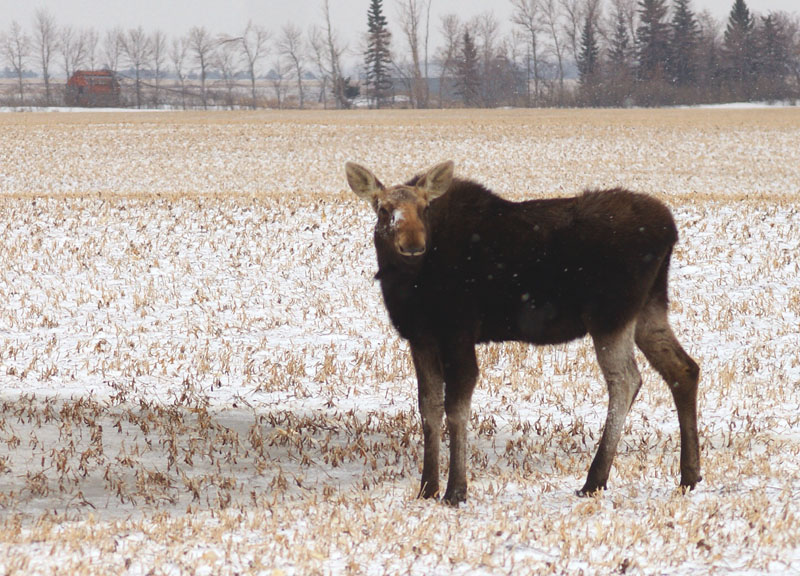Kenmare ND - Features
Real People. Real Jobs. Real Adventures.
Thanks for reading some of the latest features about area people and events.
To view every page and read every word of The Kenmare News each week,
subscribe to our ONLINE EDITION!
Moose becoming road hazards...
We all worry about hitting a deer as we’re rolling down the highway at night. If you think that’s bad, hit a 1,000-pound moose and see what happens.
3/31/20 (Tue)
We all worry about hitting a deer as we’re rolling down the highway at night. If you think that’s bad, hit a 1,000-pound moose and see what happens.
An increasing moose population in northwestern
Jason Smith is a big game management biologist with the North Dakota Game & Fish Department. He says motorists in the northwest, especially in the Kenmare and Williston areas, should be wary of moose.
“Moose are common enough that collisions with vehicles sometimes occur,” Smith said. “When driving in moose country, especially in the winter, slow down. If a moose moves into the path of your vehicle, stop as quickly as you safely can, but don’t swerve. Swerving may cause you to lose control of your vehicle.”
According to Smith, the North Dakota Department of Transportation contacted Game & Fish because it received requests from the public wanting signs placed on roadways where moose accidents were most common, similar to what they would do for deer crossing signs.
“I track non hunting related moose mortality in the state as they are reported by the public or staff,” Smith said. “Primarily game wardens and I provided the vehicle collision information that I had collected to the North Dakota DOT and likely they used some of that information to place signs.”
As moose become more populated in the northwest, human fascination with the large herbivore increases, according to Smith. He says it’s best to be very cautious around a moose because they are unpredictable.
Game & Fish provides these tips if you encounter a moose.
The key to coexisting with moose is to avoid confrontations by giving them plenty of space:
• Never approach a moose. They may look docile, but they are wild animals and may act unpredictably. Always stay at least 100 yards away from any moose.
• While moose are generally perceived as less dangerous than some other large wild animals like bears and bison, across the country many people are injured each year by moose.
• Moose will normally flee when they feel threatened, but under certain circumstances, they can become aggressive.
• When a moose feels threatened, the long hairs on its hump may raise, and it may lay its ears back (much like a dog or a horse). It may also lick its lips, but if you can see this, you are much too close to the moose.
• A moose that walks slowly toward you is giving you a warning to get away. If a moose comes toward you or charges, run or walk quickly and get behind something solid, like a tree or a car, or retreat to a safe place, like a building or a vehicle.
• Never turn your back on a moose. Always have eyes on as you move away from it.
Because of the increase in population, Smith says Game & Fish is well aware of landowner tolerance limits that are happening in northwestern
Moose have also been seen recently bunching up in farm fields. Smith said that is mainly due to them having good cover and security of forage.
By spring and summer a moose needs about 50 to 60 pounds of food in a day and if they hang around long enough, can do considerable damage to crops. In that case, Game & Fish may be able to direct license landowners.
“When determining the number of moose (hunting) licenses, harvest and population trends certainly factor into the equation,” he said. “But it’s also important to have a balance of landowner tolerance and hunter demand.”
He added, “There was an overall statewide increase from 245 licenses in 2016 to 470 licenses for 2020 (92 percent) with the main increase in anterless permits from 80 in 2017 to 270 for 2020, a 238 percent increase. The primary increases were for units M9, M10 and Mll.”
Overall, it represents a drop of five licenses from 2019. However, 190 licenses will be offered in M10 this year and 130 in M11.
M9 is an area from
M10 includes any area north and west of
M4, in the
“Moose do well in northwest
Smith added there have been some suspect cases here in the northwest, but brain worm is relatively rare in this part of
Smith squelched the misconception that there are several species of moose. There is only one species of moose, known in the biology world as alces alces.
“There are four subspecies considered for North America, but that is currently up for debate with a recently published article addressing phylogeography of moose in western North America looking at genetic differences or lack thereof between those subspecies,” Smith said. “There can be variations within populations but those would be morphological differences and can vary by sex, age and quantity of food and forage.” ... Read EVERY WORD on EVERY PAGE of The Kenmare News by subscribing--online or in print!


